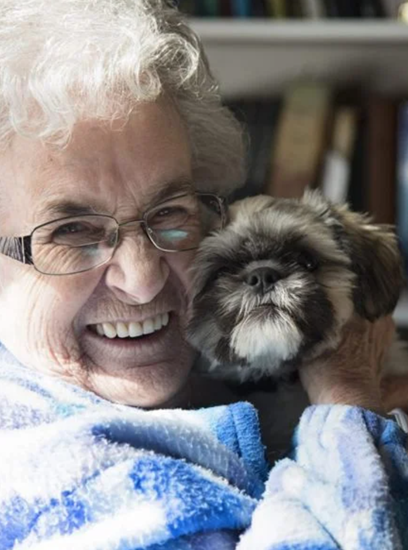
Problems with teeth
Just as overcrowding of teeth in humans presents dental and gum issues, so does the overcrowding of a dog’s mouth. As the brachycephalic breeds have a shortened skull, it follows that they have a shortened jaw, yet the number and size of their teeth remain the same as those of their species with longer snouts.
Fitting these teeth into a smaller area can lead to an overlap and increases the risk of decay and gum disease due to the build-up of plaque and bacteria trapped between tooth and gum, leading to inflammation, infection and a breakdown of gum tissue. There is also the issue of malocclusion, when the teeth do not align correctly, which can cause pain as the teeth are so close to one another.
We recommend...
If you’re adding a flat-faced breed to your family, ask the current owner, breeder, or vet if its parents have ever had any dental issues. Introduce a good home dental routine, with daily teeth-brushing and plenty of chew toys to help them keep their teeth clean.
We also recommend that a professional dental clean is undertaken regularly, so that the vet can reach into the difficult areas of the teeth and remove trapped food safely whilst your pet is sedated.
Treatment
A simple case of a build-up of plaque can be addressed with a robust routine dental cleaning process. Issues arise when the gumline has been compromised and the support structure around the teeth has been damaged to such a stage where the only sensible thing to do is to anaethetise the pet and surgically remove the damaged teeth. Remember, pets cannot tell us when they are in pain.
Staying on top of oral hygiene in all dogs, but especially the over-crowded mouth of flat-faced dogs, is essential to their health and wellbeing. Regularly check your dog’s teeth and gumline and seek professional advice if you suspect any signs of deterioration in their oral health.

Problems with skin and ears
As the skull of these shorter nosed breeds is notably smaller than their longer-nosed friends, the amount of skin that gathers around the face and narrowed ear canals is also increased.
These folds of skin do not lend themselves well to good ventilation and cooling and, as such, can create yeast infections that can become very sore. There is also the risk of the folds around the nose can trap debris leading to infection.
Things to look out for include:
- Sensitivity to touch
- Excessive scratching
- An unpleasant odour (if infection has developed in the folds)
- Discharge
- Inflamed, puffy red skin
- Thickened, darker skin
We recommend...
Due to the excess skin, your dog will find it more difficult to clean thoroughly between the folds, so a daily check and gentle removal of sweat and debris will help avoid discomfort and risk of infection. Always ensure the skin is dry after cleansing.
Given that these breeds struggle to regulate their temperature effectively, always find ways to help to keep your dog cool, providing a cool kitchen floor, taking walks out of the warmer times of the day and walking near water. Invest in a cooling collar or even use a damp towel to cool your dog on very warm days. If you do spot any signs of soreness, seek veterinary advice as soon as possible and access early intervention to avoid unnecessary suffering.
Treatment
Irritation may lead to an infection, so speaking to a vet will ascertain whether your dog requires a sample area of skin to be tested (for bacteria or fungi), in which case the treatment is usually a topical antibiotic. In severe or recurrent skin fold infections, your vet may talk to you about the surgical removal of the affected skin to avoid future pain and infection.

Problems with eyes
One of the most common problems with the eyes of flat-faced dogs is caused by their eyelid anatomy. The eyelids can tend to turn inwards (entropion), or outwards (ectropion), leading to damage of the cornea or damage due to contact with the eyelashes.
The shape and size of brachycephalic dogs often means they are susceptible to ulcers and infections. In some breeds, where the eyes bulge due to their shallow eye sockets, their eyelids cannot adequately cover the corneas, resulting in dry, irritated eyes that can become scarred over time, and in worst case scenarios, lead to blindness. These dogs are also prone to tear staining, where the eyes are constantly draining due to tear duct problems.
Things to look out for include:
- Behavioural changes, such as squinting or an eye remaining closed
- Excessive blinking
- Sensitivity to light
- Rubbing at the eyes with a paw
- Discharge
- Redness
- Cloudiness of the eye
- Excessive watering
We recommend...
There could be a number of underlying causes behind your dog’s eye health issues. However, damage to the cornea and ulceration in flat-faced dogs is something that will always need veterinary intervention. If you notice any of the above symptoms, it is essential to seek professional advice and plan with your vet the correct approach to treatment for your dog and situation.
Treatment
Depending on the nature and severity of the eye problem, a treatment plan should be tailored, and your vet will be best placed to advise on this. Treatment may be as simple as antibiotic eye drops to something more involved such as surgery for eyelids, and in more serious ulcers, you made need a referral to a specialist ophthalmologist.
